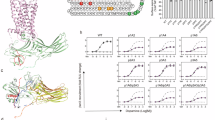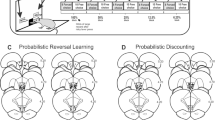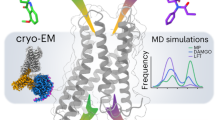Abstract
Morphine is a widely used analgesic in humans that is associated with multiple untoward effects, such as addiction and physical dependence. In rodent models, morphine also induces locomotor activity. These effects likely involve functionally selective mechanisms. Indeed, G protein-coupled receptor desensitization and adaptor protein β-arrestin 2 (βarr2) through its interaction with the μ-opioid receptor regulates the analgesic but not the rewarding properties of morphine. However, βarr2 is also required for morphine-induced locomotor activity in mice, but the exact cellular and molecular mechanisms that mediate this arrestin-dependent behavior are not understood. In this study, we show that βarr2 is required for morphine-induced locomotor activity in a dopamine D1 receptor (D1R)-dependent manner and that a βarr2/phospho-ERK (βarr2/pERK) signaling complex may mediate this behavior. Systemic administration of SL327, an MEK inhibitor, inhibits morphine-induced locomotion in wild-type mice in a dose-dependent manner. Acute morphine administration to mice promotes the formation of a βarr2/pERK signaling complex. Morphine-induced locomotor activity and formation of the βarr2/pERK signaling complex is blunted in D1R knockout (D1-KO) mice and is presumably independent of D2 dopamine receptors. However, D1Rs are not required for morphine-induced reward as D1-KO mice show the same conditioned place preference for morphine as do control mice. Taken together, these results suggest a potential role for a D1R-dependent βarr2/pERK signaling complex in selectively mediating the locomotor-stimulating but not the rewarding properties of morphine.
Similar content being viewed by others
Log in or create a free account to read this content
Gain free access to this article, as well as selected content from this journal and more on nature.com
or
References
Ahn S, Shenoy SK, Wei H, Lefkowitz RJ (2004). Differential kinetic and spatial patterns of beta-arrestin and G protein-mediated ERK activation by the angiotensin II receptor. J Biol Chem 279: 35518–35525.
Beaulieu JM, Gainetdinov RR, Caron MG (2009). Akt/GSK3 signaling in the action of psychotropic drugs. Annu Rev Pharmacol Toxicol 49: 327–347.
Beaulieu JM, Sotnikova TD, Gainetdinov RR, Caron MG (2006). Paradoxical striatal cellular signaling responses to psychostimulants in hyperactive mice. J Biol Chem 281: 32072–32080.
Beaulieu JM, Sotnikova TD, Marion S, Lefkowitz RJ, Gainetdinov RR, Caron MG (2005). An Akt/beta-arrestin 2/PP2A signaling complex mediates dopaminergic neurotransmission and behavior. Cell 122: 261–273.
Beaulieu JM, Sotnikova TD, Yao WD, Kockeritz L, Woodgett JR, Gainetdinov RR et al. (2004). Lithium antagonizes dopamine-dependent behaviors mediated by an AKT/glycogen synthase kinase 3 signaling cascade. Proc Natl Acad Sci USA 101: 5099–5104.
Beaulieu JM, Tirotta E, Sotnikova TD, Masri B, Salahpour A, Gainetdinov RR et al. (2007). Regulation of Akt signaling by D2 and D3 dopamine receptors in vivo. J Neurosci 27: 881–885.
Becker A, Grecksch G, Kraus J, Peters B, Schroeder H, Schulz S et al. (2001). Loss of locomotor sensitisation in response to morphine in D1 receptor deficient mice. Naunyn Schmiedebergs Arch Pharmacol 363: 562–568.
Bohn LM, Gainetdinov RR, Sotnikova TD, Medvedev IO, Lefkowitz RJ, Dykstra LA et al. (2003). Enhanced rewarding properties of morphine, but not cocaine, in beta(arrestin)-2 knock-out mice. J Neurosci 23: 10265–10273.
Bohn LM, Lefkowitz RJ, Caron MG (2002). Differential mechanisms of morphine antinociceptive tolerance revealed in (beta)arrestin-2 knock-out mice. J Neurosci 22: 10494–10500.
Bohn LM, Lefkowitz RJ, Gainetdinov RR, Peppel K, Caron MG, Lin FT (1999). Enhanced morphine analgesia in mice lacking beta-arrestin 2. Science (New York, NY) 286: 2495–2498.
Borgkvist A, Usiello A, Greengard P, Fisone G (2007). Activation of the cAMP/PKA/DARPP-32 signaling pathway is required for morphine psychomotor stimulation but not for morphine reward. Neuropsychopharmacology 32: 1995–2003.
Chen J, Rusnak M, Luedtke RR, Sidhu A (2004). D1 dopamine receptor mediates dopamine-induced cytotoxicity via the ERK signal cascade. J Biol Chem 279: 39317–39330.
Conner DA, Mathier MA, Mortensen RM, Christe M, Vatner SF, Seidman CE et al. (1997). Beta-arrestin1 knockout mice appear normal but demonstrate altered cardiac responses to beta-adrenergic stimulation. Circ Res 81: 1021–1026.
DeWire SM, Ahn S, Lefkowitz RJ, Shenoy SK (2007). Beta-arrestins and cell signaling. Annu Rev Physiol 69: 483–510.
Di Chiara G, Imperato A (1988a). Drugs abused by humans preferentially increase synaptic dopamine concentrations in the mesolimbic system of freely moving rats. Proc Natl Acad Sci USA 85: 5274–5278.
Di Chiara G, Imperato A (1988b). Opposite effects of mu and kappa opiate agonists on dopamine release in the nucleus accumbens and in the dorsal caudate of freely moving rats. J Pharmacol Exp Ther 244: 1067–1080.
Drago J, Gerfen CR, Lachowicz JE, Steiner H, Hollon TR, Love PE et al. (1994). Altered striatal function in a mutant mouse lacking D1A dopamine receptors. Proc Natl Acad SciUSA 91: 12564–12568.
Ferguson SS, Downey III WE, Colapietro AM, Barak LS, Menard L, Caron MG (1996). Role of beta-arrestin in mediating agonist-promoted G protein-coupled receptor internalization. Science (New York, NY) 271: 363–366.
Gainetdinov RR, Premont RT, Bohn LM, Lefkowitz RJ, Caron MG (2004). Desensitization of G protein-coupled receptors and neuronal functions. Annu Rev Neurosci 27: 107–144.
Giros B, Jaber M, Jones SR, Wightman RM, Caron MG (1996). Hyperlocomotion and indifference to cocaine and amphetamine in mice lacking the dopamine transporter. Nature 379: 606–612.
Greengard P (2001). The neurobiology of slow synaptic transmission. Science (New York, NY) 294: 1024–1030.
Haberstock-Debic H, Kim KA, Yu YJ, von Zastrow M (2005). Morphine promotes rapid, arrestin-dependent endocytosis of mu-opioid receptors in striatal neurons. J Neurosci 25: 7847–7857.
Hoeflich KP, Luo J, Rubie EA, Tsao MS, Jin O, Woodgett JR (2000). Requirement for glycogen synthase kinase-3beta in cell survival and NF-kappaB activation. Nature 406: 86–90.
Johnson SW, North RA (1992). Opioids excite dopamine neurons by hyperpolarization of local interneurons. J Neurosci 12: 483–488.
Jones SR, Gainetdinov RR, Hu XT, Cooper DC, Wightman RM, White FJ et al. (1999). Loss of autoreceptor functions in mice lacking the dopamine transporter. Nat Neurosci 2: 649–655.
Juhasz JR, Hasbi A, Rashid AJ, So CH, George SR, O'Dowd BF (2008). Mu-opioid receptor heterooligomer formation with the dopamine D1 receptor as directly visualized in living cells. Eur J Pharmacol 581: 235–243.
Kelly MA, Rubinstein M, Asa SL, Zhang G, Saez C, Bunzow JR et al. (1997). Pituitary lactotroph hyperplasia and chronic hyperprolactinemia in dopamine D2 receptor-deficient mice. Neuron 19: 103–113.
Lefkowitz RJ, Shenoy SK (2005). Transduction of receptor signals by beta-arrestins. Science (New York, NY) 308: 512–517.
Liu Y, Wang Y, Jiang Z, Wan C, Zhou W, Wang Z (2007). The extracellular signal-regulated kinase signaling pathway is involved in the modulation of morphine-induced reward by mPer1. Neuroscience 146: 265–271.
Missale C, Nash SR, Robinson SW, Jaber M, Caron MG (1998). Dopamine receptors: from structure to function. Physiol Rev 78: 189–225.
Raehal KM, Walker JK, Bohn LM (2005). Morphine side effects in beta-arrestin 2 knockout mice. J Pharmacol Exp Ther 314: 1195–1201.
Rouge-Pont F, Usiello A, Benoit-Marand M, Gonon F, Piazza PV, Borrelli E (2002). Changes in extracellular dopamine induced by morphine and cocaine: crucial control by D2 receptors. J Neurosci 22: 3293–3301.
Smith JW, Fetsko LA, Xu R, Wang Y (2002). Dopamine D2L receptor knockout mice display deficits in positive and negative reinforcing properties of morphine and in avoidance learning. Neuroscience 113: 755–765.
Sora I, Takahashi N, Funada M, Ujike H, Revay RS, Donovan DM et al. (1997). Opiate receptor knockout mice define mu receptor roles in endogenous nociceptive responses and morphine-induced analgesia. Proc Natl Acad Sci USA 94: 1544–1549.
Urban JD, Clarke WP, von Zastrow M, Nichols DE, Kobilka B, Weinstein H et al. (2007). Functional selectivity and classical concepts of quantitative pharmacology. J Pharmacol Exp Ther 320: 1–13.
Valjent E, Corbille AG, Bertran-Gonzalez J, Herve D, Girault JA (2006a). Inhibition of ERK pathway or protein synthesis during reexposure to drugs of abuse erases previously learned place preference. Proc Natl Acad Sci USA 103: 2932–2937.
Valjent E, Corvol JC, Trzaskos JM, Girault JA, Herve D (2006b). Role of the ERK pathway in psychostimulant-induced locomotor sensitization. BMC Neurosci 7: 20.
von Zastrow M (2004). A cell biologist's perspective on physiological adaptation to opiate drugs. Neuropharmacology 47 (Suppl 1): 286–292.
Wei H, Ahn S, Barnes WG, Lefkowitz RJ (2004). Stable interaction between beta-arrestin 2 and angiotensin type 1A receptor is required for beta-arrestin 2-mediated activation of extracellular signal-regulated kinases 1 and 2. J Biol Chem 279: 48255–48261.
Zhang J, Ferguson SS, Barak LS, Bodduluri SR, Laporte SA, Law PY et al. (1998). Role for G protein-coupled receptor kinase in agonist-specific regulation of mu-opioid receptor responsiveness. Proc Natl Acad Sci USA 95: 7157–7162.
Acknowledgements
This work was supported in part by the National Institutes of Health, grant numbers RO1-MH-0753 and U-19-MH-082441. We thank Wendy Roberts, Xiuqin Zhang, and Katherine Harley for maintenance of the mouse colony. D2 DA receptor knockout mice were generously provided by Dr Malcolm J Low at the Oregon Health and Science University in Portland, Oregon. D1 DA receptor mice were generously provided originally by Dr John Drago (NIH). GSK3β +/− mice were generously provided by Dr James Woodgett at the Samuel Lunenfeld Research Institute, Toronto, Canada.
Author information
Authors and Affiliations
Corresponding author
Ethics declarations
Competing interests
MGC owns stock of Acadia Pharmaceutical. He has consulted and received compensation from Lundbeck, Roche, and Merck. He has also received compensation in the form of honoraria for lecturing at various scientific meetings and academic institutions. None of the above presents any conflicts of interest with the results being described in this paper. Other authors have no disclosures/conflicts of interest.
Additional information
Supplementary Information accompanies the paper on the Neuropsychopharmacology website
Rights and permissions
About this article
Cite this article
Urs, N., Daigle, T. & Caron, M. A Dopamine D1 Receptor-Dependent β-Arrestin Signaling Complex Potentially Regulates Morphine-Induced Psychomotor Activation but not Reward in Mice. Neuropsychopharmacol 36, 551–558 (2011). https://doi.org/10.1038/npp.2010.186
Received:
Revised:
Accepted:
Published:
Issue date:
DOI: https://doi.org/10.1038/npp.2010.186
Keywords
This article is cited by
-
A role for cortical dopamine in the paradoxical calming effects of psychostimulants
Scientific Reports (2022)
-
Facilitating mGluR4 activity reverses the long-term deleterious consequences of chronic morphine exposure in male mice
Neuropsychopharmacology (2021)
-
D1 dopamine receptors intrinsic activity and functional selectivity affect working memory in prefrontal cortex
Molecular Psychiatry (2021)
-
Targeting β-Arrestins in the Treatment of Psychiatric and Neurological Disorders
CNS Drugs (2021)
-
Influence of G protein-biased agonists of μ-opioid receptor on addiction-related behaviors
Pharmacological Reports (2021)



